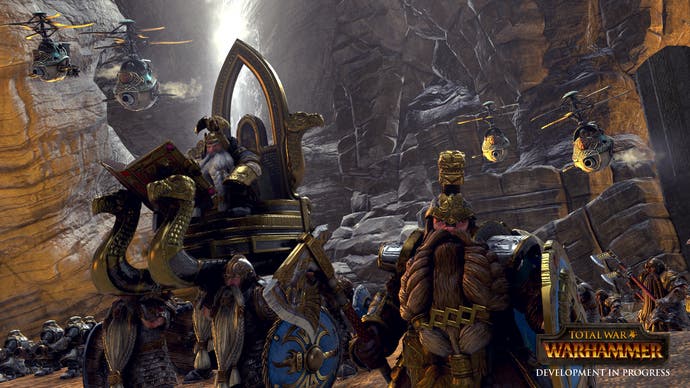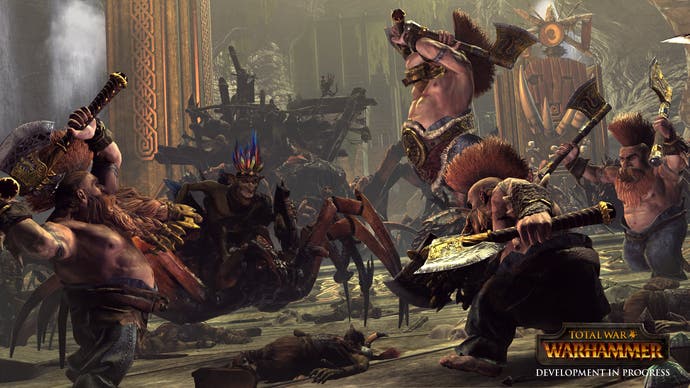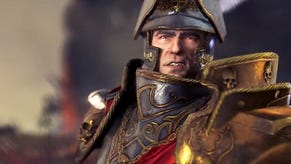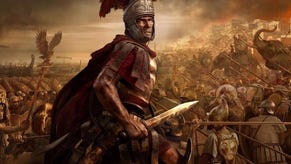Our first hands-on with Total War: Warhammer
Going Underground.
My Dwarfs (not Dwarves) are standing their ground. A line of heavily armoured infantry supported by crossbowmen, handgunners and around 50 flamethrowers. They wait patiently, as Dwarfs often do, for a much larger force of Greenskins to crash upon their ranks. Outnumbered and then some, but not yet outgunned, they've brought with them some rather formidable artillery: two sets of Organ Guns, named for their resemblance to the musical instrument... although instead of leading hymns down at the local Methodist, they shoot lots of tiny cannon balls at a pleasing rate of fire. (It makes sense when you see them in action.) My other cannon shoots flames and is called a Flame Cannon. That one is probably a little easier to picture.
So here we are, fending off an ambush in one of the many lost underground tunnels that make up The Underway. 1300 dwarfs hold formation as a horde of Goblins (some riding spiders) rushes towards them. And we've got cannons! Wonderful, beautiful cannons! This, right here, is what I've been waiting for. It's what the name Total War: Warhammer always promised and I was delighted to find that it lived up to those high expectations.
As with the first battle we saw (but didn't play) back in June, this ambush is a part of a larger quest chain. Whereas the Battle of Black Fire Pass appeared to take place quite a way into a player's campaign, I was told this encounter is meant to be played earlier on in the story of Thorgrim Grudgebearer. If you're not familiar with ol' Thorgrim, the High King of the Dwarfs is carried around the battlefield on his throne, while he reads from his infamous Book of Grudges, an ancient tome that details every wrong done to his proud Dwarfish people. That's his whole thing, right there. He's just really mad all of the time.
Total War: Warhammer is all about getting these heroes involved in the action, unlike say, Creative Assembly's Rome 2 or Attila, which tend to encourage players to keep their generals on the edge of combat, applying buffs, but rarely getting stuck in. It wouldn't have felt right to do the same with Thorgrim and it was refreshing to know I didn't need to. Although not protected by a retinue of soldiers, as you'd also expect in other Total War games, these melee-focused heroes can take a beating, and their unit card makes it clear when they're in trouble. My initial concern that Thorgrim would be something of a glass cannon was soon put to rest.

Aside from that, your main hero (Grudgebearer, Franz etc.) can't properly die, anyway. Sure, they can fall in combat, and this would have the expected impact on the morale of your troops, but it's not game over. However, the same cannot be said for your other heroes, whom, I was told, are more expendable. As well as Thorgrim, I also had an unnamed Dwarf Thane to play around with. Described as a 'Melee Champion', you can move him around the campaign map in the same way you'd control an agent in other Total War games. I imagine this will mean getting him to wherever there's about to be a big scrap. Despite his supposed mortality, I was also able to throw him straight into the action and he did just fine. For Warhammer fans, this probably comes as no real surprise, but after years of worrying about my generals in Total War, this is a welcome change to embrace.
Fighting underground is a new one, too. Not only does it feel sort of perfect to battle against overwhelming odds while surrounded by the ruined architecture of one's ancestors, but tunnels make for superb battlefields. The majority of the Greenskin force starts at the opposite end to your own and they'll immediately start charging towards you as the battle begins. Because of the relatively flat landscape, this means you'll see them coming - and that's just as intimidating as it sounds. You want to keep an eye on that, and yet, you soon find yourself distracted. Multiple side passages allow for smaller groups of goblins to appear and hassle your lovely, neat formation at its flanks, which requires speedy repositioning. And then, just as you start to think that's under control, a group of trolls appears at your rear, accompanied by a giant. Suddenly you're turning every armour piercing ranged unit you have to face them and you pull those Slayers off the front line. It's utter chaos and of course, before you're ready for them, the main Greenskin force has arrived. This quest chain is some of the most fun I've had with Total War, and it's helped bring me round to the idea of Warhammer having a few more scripted moments here and there than Creative Assembly's other Total War games.
I started the demo thinking it would be about picking the right formation. Now, it was all about survival. Hold on long enough, we're told, and reinforcements will arrive. After one particularly heroic moment that saw me charging the aforementioned giant with both Grudgebearer and Thane, reinforcements arrive: two units of gyrocopters. Armed with small rapid-fire cannons, they're the Dwarfish equivalent of an Apache helicopter and I love them dearly. They help finish off the giant I'm struggling with before flying over the largest group of goblins I can find and dropping both sets of bombs they've brought along. So this is how flying units work. I think I'm okay with that.
Once my flanks were tidied up, everything else started to fall into place. I've played enough Total War to know how to withstand an enemy charge and when it's probably a good idea to start pushing back and mopping up fleeing units. Playing the demo on hard difficulty (I'm not bragging, Wes told me to include this) meant more enemies on the field, and it felt like just about the right level of challenge. It was a hard fought win, but I didn't need to exploit any flaws in the computer AI, which I think most of us have been guilty of at some point when it comes to Total War.

Unfortunately, I didn't get the chance to use any of the magic we saw in that first hands-off demo, but even still, I can tell this is a very different kind of Total War. I wasn't used to controlling such a varied roster of unit types, which meant plenty of pausing and comparing stats and traits. Total War has never been quite as simple as rock-paper-scissors, despite looking that way at first glance, but Warhammer brings with it even more variants. And yet, I found it a surprisingly easy transition. Apart from my two heroes and those gyrocopter reinforcements, there weren't an abundance of active abilities to worry about. In fact, the biggest challenge came with trying to remember which units could reliably damage larger enemies; a challenge made slightly easier, I admit, by the unit trait 'Anti-Large'. Man, I love Warhammer lingo.
Speaking of which, I suspect that Warhammer fans will find this process even easier, as so many of the tabletop rules apply. You'll likely be dealing with more units than before, but knowing which units are best equipped to counter others will prove useful. Haven't played a Total War game before? I wouldn't let that put you off. That being said, this game is probably going to be the reason that you end up spending an absolute fortune upgrading your PC. Sorry about that and welcome to the club!
All in all, it was an excellent first demo, as is usually the case from The Creative Assembly. I continue to be excited about the prospect of a Total War game set in the Warhammer universe, although of course, there are still some important questions to be answered. Can they get magic right? I still can't quite shake the feeling that it's going to be too powerful, despite hearing assurances that the most impressive spells will be a rare sight on the battlefield. And how about the campaign map? The Greenskins, for example, are never meant to be diplomats, nor are they builders. So what does their campaign even look like? Can that playstyle fit with the Total War formula?
For now, though, there is one question I can answer quite firmly indeed: can these two franchises work together as well as we'd hoped? Yes. Yes they absolutely can.










